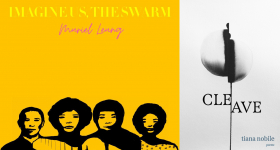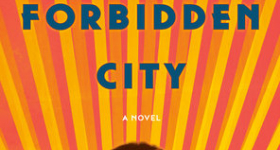In an era of book-to-film adaptations a la Hidden Figures or book-to-TV adaptations like The Handmaid’s Tale, Jimin Han’s debut novel, A Small Revolution, spins the trend on its head by reading, instead, like a literary adaptation of a miniseries, a visual and visceral journey through some of storytelling’s most familiar tropes: love, innocence, loss of innocence; violence, corruption, deception; duty to country, to others, to self; and personal truths versus reality.
This to say that Han’s A Small Revolution has all the makings of a riveting, sensory experience, though the narrative is instead encapsulated in 212 pages of beautifully written prose. The novel weaves together the personal and the political while examining the friction between internal and external struggles, and the result is a textured work about coming-of-age that engages readers and reassures them that, indeed, “there are many paths to revolution.”
A Small Revolution opens with a haunting scene: Early morning. A woman is being chased by a man on a foggy college campus somewhere in the middle of Pennsylvania. Within the first 50 words, he has caught up to her and tackled her to the ground. The narrator observes all of this from above, from her window, unflinchingly.
And indeed, the rest of the novel unfolds with this same steadiness of tone and matter-of-fact commentary, lending the narrative an element of detachment and numbness. The story slides seamlessly between two realities throughout the book: the present-day reality that narrator Yoona Lee lives in -- being held hostage with three classmates in her college dorm room, and the reality she yearns to return to -- July 1985, falling in love with Jaesung Kim, a charismatic college student with his eyes turned toward martyrdom amid South Korea’s political unrest.
In both worlds, Yoona is more observer than active participant, the flow of the novel following her gentle musings and reflections as the action around her unfolds. In the present day, she and her three friends -- Daiyu, Faye, and Heather — are being threatened at gunpoint by a former friend of hers -- one Lloyd Kang -- who seems to be on the brink of breakdown following a mysterious accident in Korea that killed Jaesung, Yoona’s love and his best friend.
Jimin Han
There are no chapters in Revolution; rather, Han chose to use numbered sections instead, moving deftly between the past and present day, with Yoona’s thoughts interspersed throughout. (“My mother said, ‘Don’t trust a man, ever.’ My sister said, ‘Don’t trust anyone.’ My father said, ‘No one understands me in this house.’”) The result is an uninterrupted deluge of memories that allows the reader to really get inside Yoona’s head, and furthermore, allowed Han to play with the foreground and background of the narrative -- at times, Yoona’s memories feel more vivid and palpable than her bleak present.
Jaesung, too, is a character-turned-device that ultimately helps to highlight Yoona’s transformation throughout the novel. He is omnipresent throughout the story, though he physically exists only in Yoona’s memory. The entire novel is, arguably, one long nonverbal address to Jaesung; in it, Han employed an almost epistolary approach, with Yoona imploring an absent “you” to return, to help her remember the happier, more carefree moments of her life prior to Jaesung’s dramatic death. The effect of the conceit is intimate, with Yoona’s emotions made all the more immediate because of that broken fourth wall.
At one critical flashback/turning point in the narrative, Yoona reflects on the moment just before she was swept up into a protest march in South Korea, and what she would have wanted to say to Jaesung.
(I know I should have said something to you here. This was my last chance. If I could go back to that moment, I would have said something about what we should do if we’re separated. I’d devise a plan. But how could I have known? Everything until that moment had been easy. We’d escaped everything. Even the trouble in the tour group with the leaders — we’d broken all the rules, and we’d never had to pay.)
On the other end of the spectrum, then, antagonist Lloyd plays the perfect foil to Yoona’s superficially calm demeanor (her internal monologues, like the one above, reveal a much richer landscape of emotions). In the present day, he is a mechanized version of himself, firing off his demands in all-caps (“SAY IT. I’LL KILL HEATHER TO MAKE YOU SAY IT. YOU KNOW I WILL”), all of his thoughts and emotions explosive and dehumanized by the form they take on the page. (“Lloyd shouts as if his words are coming out of a body that is itself a gun,” Yoona muses at one point.)
But with Lloyd, as with other characters and elements in the novel, there are a multitude of layers and circumstances from the past that contribute to his present. In fact, the momentum of the novel is almost entirely predicated on the suspense of not just “what will happen next?” but “what happened in the past?” Because the narrative jumps between past and present, there is as much mystery about the cause as there is the effect, and this is the strength of Han’s skillful layering.
Ultimately, Han seems to be arguing, the paths we take to get to our present selves are littered with decisions and experiences that will impact our future selves, but in the chaos of our present, we often don’t recognize the small revolutions that are taking place within. In other words, there are no such things as accidents, only a belated sense of understanding. And therein lies the reader’s revelation, that all of Yoona’s present is tied to her past, and her past to her future, and Han’s careful unspooling of the narrative thread that holds the three pieces together is a powerful tapestry in reverse.
Read an excerpt of A Small Revolution here.









Comments